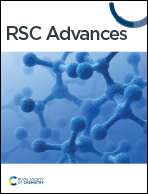Influence of external electric field on electronic structure and optical properties of β-Ga2O3: a DFT study
Abstract
The influence of different electric fields on the electronic structure and optical properties of β-Ga2O3 was studied by GGA+U method. The results show that appropriate electric field intensity can regulate the band gap of β-Ga2O3 more effectively to improve the photoelectric characteristics. The band gap value of intrinsic β-Ga2O3 is 4.865 eV, and decreases from 4.732 to 2.757 eV with the increase of electric field intensity from 0.05 to 0.20 eV Å−1. The length of the O–Ga bond along the electric field increases the fastest with the electric field intensity, and the distance between O and Ga reaches 2.52 Å when the electric field intensity is 0.20 eV Å−1. A new peak appears in the real and imaginary parts of the dielectric function for β-Ga2O3 in the low frequency region under the electric field, and the conductivity increases obviously. The optical absorption peaks induced by the electric field were observed in the wavelength range of 400–600 nm. The optical absorption of β-Ga2O3 is enhanced with an increase of electric field intensity, exhibiting a maximum value with the electric field of 0.15 eV Å−1. The electric field above 0.15 eV Å−1 causes a decrease of optical absorption intensity.



 Please wait while we load your content...
Please wait while we load your content...